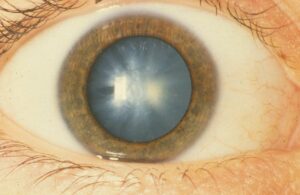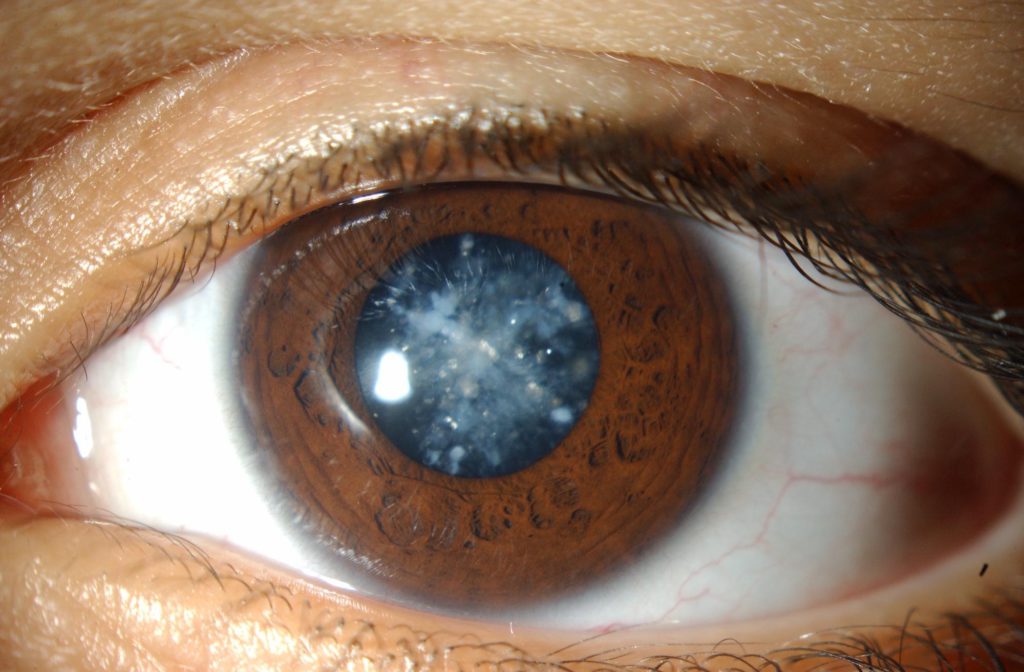If you have been having trouble seeing lately, it is important to get your eyes checked by an optometrist as soon as possible. You may be suffering from a floriform cataract, which can cause blurry vision and even blindness if left untreated. In this blog post, we will discuss the causes, symptoms, and treatment of floriform cataracts.
Contents
What Is A Floriform Cataract?
 A floriform cataract is a type of cataract that affects the eye’s lens. It is characterized by yellow-white spots or patches in the middle of the lens, resembling flowers. These patches can be large and cause significant vision loss if left untreated. This condition is often seen as part of the aging process but is also associated with certain medical conditions and eye diseases.
A floriform cataract is a type of cataract that affects the eye’s lens. It is characterized by yellow-white spots or patches in the middle of the lens, resembling flowers. These patches can be large and cause significant vision loss if left untreated. This condition is often seen as part of the aging process but is also associated with certain medical conditions and eye diseases.
If you are experiencing symptoms associated with a floriform cataract, it is important to talk to your eye doctor. Treatment options range from glasses or contact lenses to surgery, depending on the severity of your condition.
What Are Some Signs To Look For?
It might be difficult to recognize the signs of a floriform cataract at first, but it is important to be aware of potentially concerning symptoms. Some common symptoms include:
- Blurred vision
- Light sensitivity
- Double vision
- Difficulty seeing colors or details clearly
- Dark spots appear in the field of vision
These symptoms might progress until eventually the vision becomes completely obscured. This makes it difficult to perform everyday activities and might even lead to depression or anxiety in some individuals (You can also take online stress counseling, depression counseling & online anxiety counseling). Because when untreated, a floriform cataract can lead to further complications such as glaucoma, it is important to get help right away.
What Causes A Floriform Cataract?
The causes of a floriform cataract are not fully understood, but it is thought to be caused by trauma or inflammation of the eye. As this type of cataract is typically found in older adults, it could be the result of long-term damage from UV light exposure.
In addition to these causes, there are some risk factors that increase the risk of developing a floriform cataract, such as:
- Diabetes: It is thought that people with diabetes have an increased risk of developing a floriform cataract due to the chronic low levels of glucose that can damage the lens.
- High Myopia: People who are extremely nearsighted (high myopia) are also more likely to develop a floriform cataract.
- Age: As previously mentioned, floriform cataracts are more common in older adults, and the risk increases with age.
- Family history: Finally, a history of floriform cataracts within your family may increase the risk of developing one yourself.
All in all, there could be several causes and risk factors, but you should speak to your doctor for a definitive diagnosis. With the right information, you can better understand your condition and make an informed decision on how to proceed with treatment.
How Is It Diagnosed?
The diagnosis is an essential part of determining the treatment for a floriform cataract. Doctors will use a combination of a physical exam, fundus examinations, and imaging tests to make an accurate diagnosis. Let’s discuss how each of these tests helps the doctor come to a conclusion.
- Physical Exam: During a physical exam, doctors will observe the eyes for signs of cataracts like cloudy or hazy vision. They might also check your pupil reflex and color perception to determine how advanced the condition is.
- Fundus Examinations: A fundus examination uses a special microscope to examine the back of the eye. This test can help doctors identify and diagnose different types of cataracts, including floriform cataracts.
- Imaging Tests: Imaging tests like an ultrasound scan or a computed tomography (CT) scan can also help doctors diagnose a floriform cataract. These tests can provide doctors with a detailed look at the inside of the eye, including information about the size and location of any cataracts present.
Once a floriform cataract has been diagnosed, it is important to seek treatment as soon as possible to prevent further vision loss. Fortunately, there are many treatments available that can help restore vision loss caused by a floriform cataract.
How To Treat Floriform Cataracts?
 When it comes to treatment for floriform cataracts, surgery is the only option available. This can either be done in two stages or as a single-stage procedure. In a two-stage surgery, an incision is made in the eye and then a phacoemulsification device is used to break up and remove the cloudy lens material. After the lens material is removed, an artificial intraocular lens implant is inserted to replace it. In a single-stage procedure, both steps are done at the same time.
When it comes to treatment for floriform cataracts, surgery is the only option available. This can either be done in two stages or as a single-stage procedure. In a two-stage surgery, an incision is made in the eye and then a phacoemulsification device is used to break up and remove the cloudy lens material. After the lens material is removed, an artificial intraocular lens implant is inserted to replace it. In a single-stage procedure, both steps are done at the same time.
The success rate for surgery for floriform cataracts is very high and most patients recover their vision quickly. After surgery, you may need to regularly take eye drops to help keep your eye health and reduce the risk of infection. It’s also important to wear sunglasses when outside to protect your eyes from the sun’s ultraviolet rays.
If you have been diagnosed with floriform cataracts, it is important that you see an ophthalmologist or optometrist for regular check-ups and to evaluate the extent of your vision loss. It is also important to follow their advice on when and how often to have surgery in order to get the best outcomes possible.
With early diagnosis and prompt treatment, you can reduce the chance of further vision loss and restore your sight. So don’t delay seeking medical attention!
Can It Be Prevented?
Prevention may not be possible in some cases—especially when it is a result of genetic disorders. However, proper management of health-related conditions can help reduce the severity and progression of these conditions. These include diabetes, hypertension, autoimmune diseases, and eye injuries.
In addition, there are some lifestyle changes that can help reduce the risk of developing a floriform cataract. These include:
- Eating a healthy, balanced diet rich in antioxidants and omega-3 fatty acids
- Wearing protective eyewear during outdoor activities
- Quitting smoking
- Reducing alcohol consumption
- Limiting exposure to ultraviolet (UV) light
- Limiting screen time
- Wearing sunglasses that block UV rays when outdoors
- Doing regular eye exams to detect the condition early
By making these lifestyle changes, you can reduce your risk of developing a floriform cataract and slow down its progression if you already have it.
If you think that you or someone you know may be suffering from a floriform cataract, it is important to seek medical attention. Early diagnosis and treatment can help prevent the condition from worsening.
Conclusion
In conclusion, floriform cataracts are a rare form of cataracts that can have a big impact on vision. The exact cause is still unknown, but it appears to be hereditary and related to aging. The conditions can simply be defined as a curd-like opacity of the lens that causes blurring and distortion of vision. Treatment usually involves cataract surgery to replace the affected lens.
While there is currently no cure for this condition, it can be managed with regular eye exams, and corrective lenses. Amd lifestyle changes to reduce the risk of complications. With early diagnosis and appropriate care, people living with floriform cataracts can maintain good vision in their daily lives.
For more information and guidance, please consult Mantra Care. At MantraCare we have a team of experienced eye surgeons, who will be happy to answer any questions on cataract surgery. Call us at +91-9711116605 for any inquiries.
